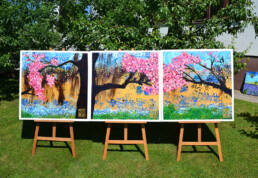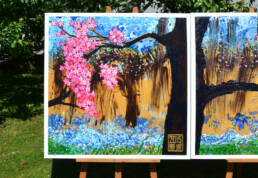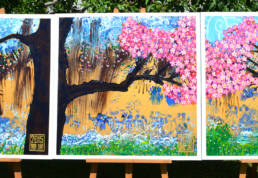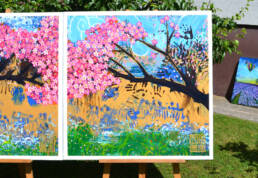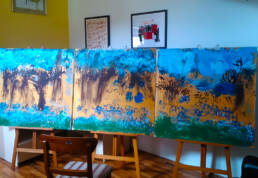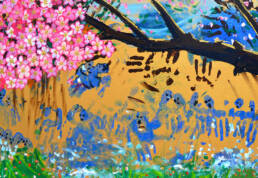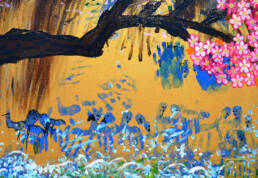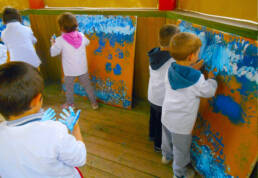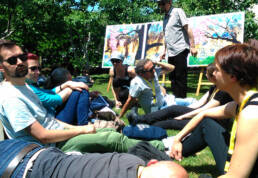Kad se male ruke slože
(When the Little Hands Gather)
For a few years I´ve been a regular visitor of the Art Colony Duga, the art colony that supports Center for the Abandoned Children Duga in Kulen Vakuf. When I get a chance, I even pay visit to Kulen Vakuf for vacation or a short break. I have a friend who is a fisherman and Kulen Vakuf is placed on the beautiful fishing spot by the river Una. The colony itself can be described as art symposium, but I would like to call it an annual gathering, where artists can meet and enjoy life for 24 hours. It´s invitation only where you keep your place by providing a good work and pleasant time for everyone else. Since the last few years, artists have been invited to hold the art workshop with children from the Center. This year I was lucky to have received such invitation and to be one of those artists.
It was cloudy and rainy Monday, the day I arrived, on the same day two new protégés arrived. A new born left in the hospital and a 5 year-old boy, left in the safe house. Important thing to know is that these children have their parents and unlike belief that they will ask you “are you my mother or father”, they are looking for the warmth that will come from a stranger. On that day I became a mythological being “čiko”, a word that children use for male adult, or if I had been a woman they would notice the arrival of “teta”. I was to sleep and work in an apartment for adopting couples, that is directly above the infants’ room. Being a father of two myself I offered to help with children, but following the rules of engagement and seeing how the staff of the center works, I realized that I would be more of trouble myself. I tried not to get in their way, silently observing everyday life in the Center. I was amazed by the tremendous job they were doing with no trouble. All the staff would start to gather in the center at around 7 in the morning and most of them would leave at around 8 or 9 in the evening. Most of them lived in the near by houses. I could easily say that they were available to those children 24/7.
When the Little Hands Gather
As for the workshop I had in mind finger painting, working on fine motorics. I prepared canvases with two layers of gold. Than I instructed kids to use different parts of the hand to paint clouds, river, grass, trees. They used their whole hand, palms, fingers and finger tips achieving different strokes and movements on canvases. Their fingers were used to draw trees and grass, for they are tall; their whole hand for clouds, their palms for the river and the fingertips for drops of water over river.
I knew that I would be doing one more sakkura inspired landscape, but I didn´t know what the base will be. Now I need to tell why I chose the title When the Little Hands Gather. When the Little Hands Gather was a song that was made for the feature movie called A Train in the Snow based on famous children’s novel written by Mato Lovrak. The movie was done in early seventies and it was very popular during my childhood, so was the song. The song itself was there to emphasize togetherness or “Brotherhood and Unity” of Yugoslavia. Although the song remained in my happy memories, it didn´t really help in maintaining brotherhood and unity as it was supposed to. Many of the children who have grown to this song committed horrible war crimes during dissolution of Yugoslavia.
I am not an artist who thinks that art should downpress people. Yet, this painting carries various unsettling feelings. Apart from being surrounded by 26 children who have been abandoned by their parents, an act unthinkable for me, I was also reading My Promised Land – The Triumph and Tragedy of Israel by Ari Shavit, the book that triggered some strong feelings that I have buried since the Bosnian War. Observing the canvases, I started to recognize a figure patterns, pogrom of the Jews, pogrom of the Palestinians, pogrom of the Bosnians, groups of ghastly refugees… And I began to read the story that randomly applied paint was telling.
From the left to the right, I saw on first two panels, a dark forest with the murky clouds over it, surrounded by the cold stream of the wild river, an omnipresence of evil nature, a realm where the wolf from the Little Red Ridinghood is the king. And in the center panel the river becomes a stream of people. In the middle part two groups of refugees, pulling their children by their hands, trying to achieve safety in constant struggle, frozen in time with the shriek deforming their faces. Bellow them couples caught in domestic violence. On the right panel, a horseman forcing people into run, separating children from their parents. Yet, the space is more open and freedom is in sight. The horseman is frozen in the background, the wind has broken the clouds and people are near the greenery.
As I was painting each day had become sunnier. I also listened to Bob Marley a lot, for mellow mood has got me so let the music rock me. To distance myself and a viewer from the struggle I used Hiroshige´s favorite technique, repoussoir, by breaking the first plan and framing panels with blooming cherry trees.
On Friday evening I applied the final layer of glossy varnish, and left it to dry for 12 hours. The day after, the finished painting was presented in the Center’s yard along other donated works of other artists. I was really happy when I caught my friends chilling in front of it.
Related links
Facebook page of the Art Colony Duga
Web site of the Centre for Children without Parental Care “DUGA”
Technique: acrylic on canvas
Size: triptych 100 x 300 cm
(39.37 x 118.11 inch);
each panel 100 x 100 cm
(39.37 x 39.37 inch)
Year: May 2015
Availability: In Collection of
Foundation “Center Duga Art”
Japanesque

